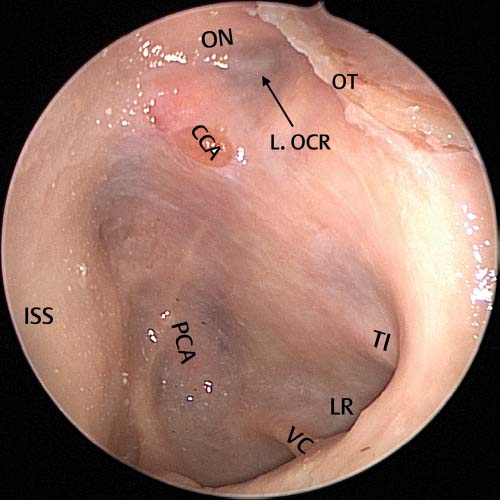18 When the sphenoid sinus is opened and entered with an endoscope the surgeon should be able to identify whether the dominant sinus is entered. If the intersinus septum attaches to the lateral wall of the sphenoid, usually in the region of the carotid artery on the opposite side to the side entered, then the pituitary fossa should be visible and the surgeon is in the dominant sinus (Fig. 18.1). If the sinus is small and the septum implants on the lateral wall directly in front of the surgeon and the pituitary fossa is not seen, the surgeon should be in the nondominant sinus. This should be correlated to the computed tomography (CT) scans. Once the intersinus septum is removed (usually with a through-biting Blakesley or diamond burr—twisting should be avoided to avoid possible damage to the carotid artery by fracturing bone), the normal structures should be identifiable. The pituitary fossa is seen in the midline with the anterior genu of the cavernous carotid seen on either side. As the carotids are followed superiorly, the optic nerves are seen at the junction of the side wall and roof. There is often a depression between the optic nerve and carotid in a well pneumatized sphenoid which represents a pneumatization of the optic strut and is termed the opticocarotid recess (OCR) (Fig. 18.2). Between the medial aspect of the optic nerve at the point where it leaves the sphenoid and the anteriosuperior medial region of the carotid, is a slight thickening of bone termed the medial OCR and it corresponds to pneumatization into the medial clinoid process. On the lateral wall the V2 branch of the trigeminal nerve can be seen as well as the vidian nerve in the floor of the sinus. Posterior in the midline below the pituitary fossa the clivus is visible. Depending on the sphenoid pneumatization this bone may be either thick or quite thin. On either side of the clivus are the vertical paraclival portions of the carotid (Fig. 18.2). These are important landmarks for any surgical approach to the clivus. Above the pituitary fossa is the tuberculum sella; this is a thickened area of bone that forms the junction between the anterior face of the pituitary fossa and the roof of the sphenoid (termed the planum sphenoidale). Bone is removed from cavernous sinus to cavernous sinus, onto the floor of the fossa and up to the tuberculum sella. Care must be taken as the tuberculum sella is approached as there is a fold of dura that comes down with the tuberculum sella and, if this is grabbed with the Kerrison punch, a cerebrospinal fluid (CSF) leak will result. Once the bone over the pituitary fossa has been removed, the underlying periosteum is exposed. Between the periosteum and the dura is a potential space. This space is occupied by venous channels that connect the cavernous sinuses in the upper and lower regions of the pituitary (Fig. 18.3). In most macroadenomas these venous channels are obliterated by the pressure from the enlarging tumor. However, in microadenomas and tuberculum sella meningiomas, these venous plexuses remain and can bleed significantly when opened. Bipolar cautery may seal the channels but often the most effective way is to open the dura and then attempt to seal the two layers with bipolar cautery. If this fails then Gelfoam (Pharmacia and Upjohn Company, Kalamazoo, MI) paste (or Surgiflo [ Ethicon, Somerville, NJ]) can be used. This is injected into the region and pressure is applied with a neuropattie. If bleeding persists, Ligar clips can be applied (Medtronic ENT skull base instrument set Ligar clip applicator [Jacksonville, FL]) to the two layers to seal them together. The lateral wall of the pituitary fossa is formed by the cavernous sinus and the cavernous portion of the carotid artery. It is important for the surgeon to have a clear understanding of the carotid artery in the lateral wall. Tumor is routinely removed from the lateral wall with suction and standard pituitary curettes so knowing where to expect the carotid is important for the surgeon so that care is taken not to apply any pressure over the carotid. Tumor may also need to be followed into the cavernous sinus so this anatomical understanding is crucial for the surgeon to understand so the tumor may be followed. Figure 18.4 shows the normal course of the carotid in the lateral wall and the areas where extra care needs to be taken. Fig. 18.1 The suction rests on the pituitary sella with a clear view of the carotid artery (ICA) and the optic nerve (ON), indicating that the surgeon is in the dominant sphenoid sinus. Fig. 18.2 Cadaveric dissection image taken of the left sphenoid sinus through a maximal sphenoidotomy. The vidian canal (VC) and trigeminal impression (TI) for the maxillary division of the trigeminal nerve can be clearly seen. If the sphenoid sinus is well pneumatized then the lateral recess (LR) can be seen, a depression in the lateral sphenoid wall between the VC and the TI. The lateral opticocarotid recess can be seen. This depression corresponds to pneumatization of the optic strut (the bony bridge that separates the optic canal from the superior orbital fissure). Further pneumatization into the optic strut may result in a pneumatized anterior clinoid process which will place the optic nerve on a mesentery. The optic tubercle (OT) is the bone located at the junction of the orbital apex and the sphenoid sinus. ISS, intersinus septum; ON, optic nerve; CCA, anterior genu of the intracavernous carotid artery; PCA, paraclival carotid artery.
Anatomy of the Sphenoid and
Adjacent Structures of Importance
during Skull Base Surgery
 Anatomy of the Pituitary Fossa
Anatomy of the Pituitary Fossa
 Lateral Wall of the Pituitary Fossa
Lateral Wall of the Pituitary Fossa
Stay updated, free articles. Join our Telegram channel

Full access? Get Clinical Tree




